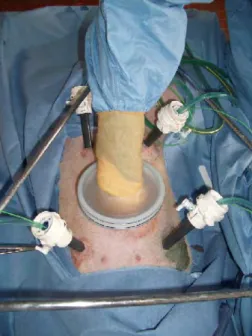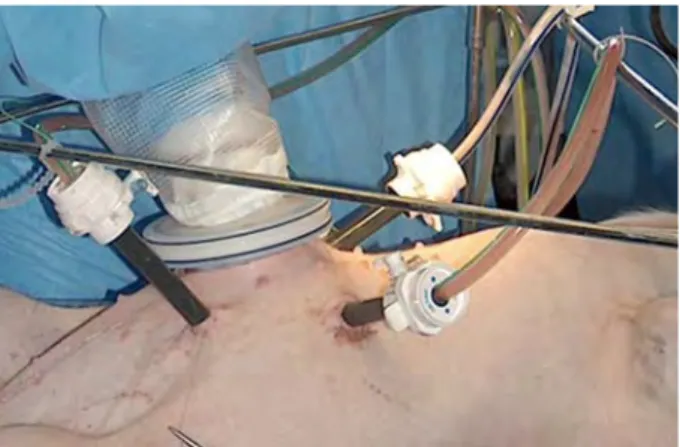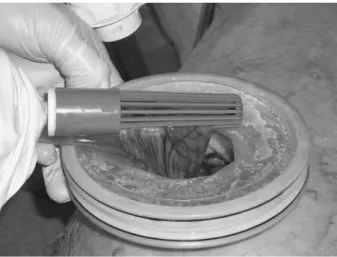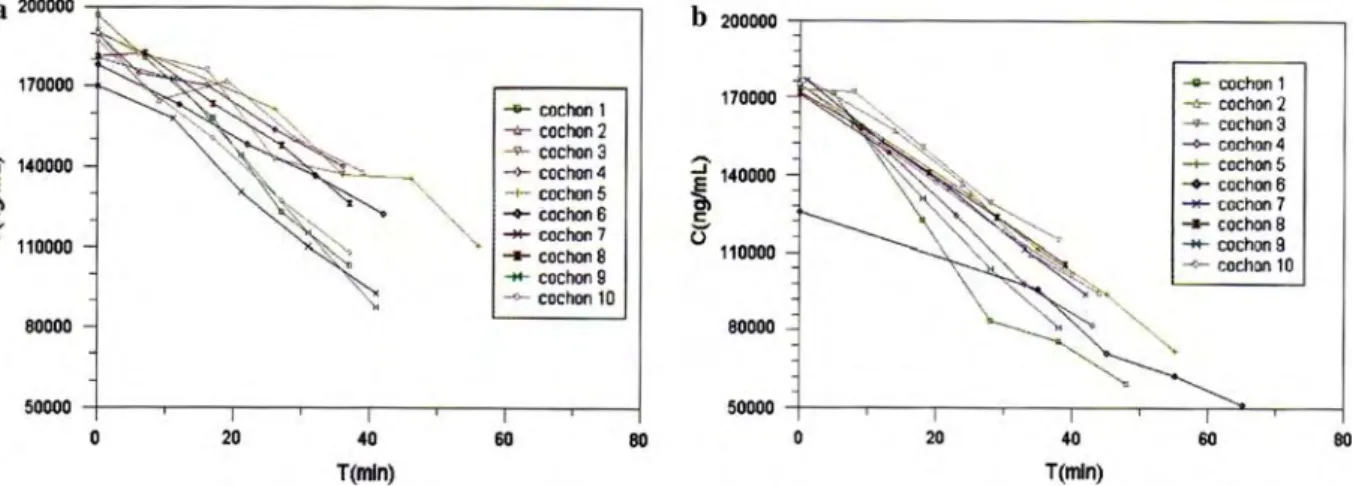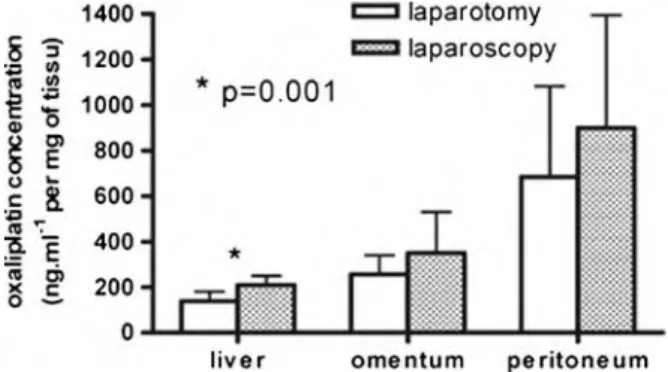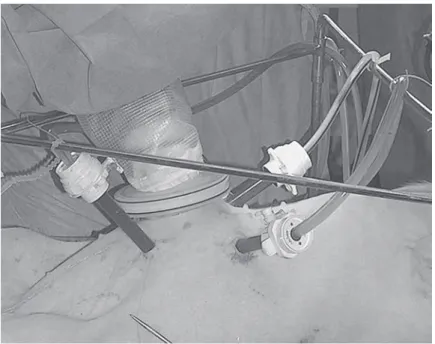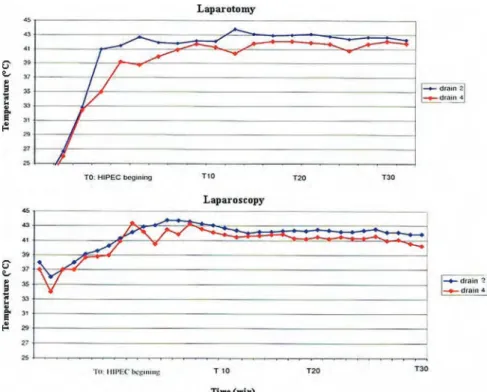Université Fédérale
Toulouse Midi-Pyrénées
t
THESE
En vue de
l'obtention
duDOCTORAT
DE
L,UNIVERSITÉ
DE
TOULOUSE
Délivré par:
Université Toulouse 3 Paul Sabatier (UT3 Paul Sabatier)
Si vous êtes en cotutelle internationale, remplissez ce champs en notant: Cotutelle internationale avec
'nom de l'établissement", sinon effacer ce texte pour qu'il n'apparaisse pas à I'impression Présentée et soutenue par s
Thierry - Gwénaël FERRON
le vendredilg juin 20I5
Titre:
THERAPEUTIC METHODS FOR PERITONEAL CARCINOMATOSIS
STAN DARDIZATION OF HYPERTHERM IC INTRAPERITONEAL CHEMOTHERAPY PHARMACOKI N ECTICS AN D PHARMACODYNAMIC STU DIES
Êcole doctorale et discipllne ou spécialité: ED BSB : Biotechnologies, Cancérologie
Unité de recherche:
EA 4553 lndividualisation des traitements des cancers de l'ovaire (IUCT-O) Directeur/trlce(s) de Thèse :
Pr BCttiNA COUDERC
PrJean Pierre DELORD lury:
Pr Olivier GLEHEN (Rapporteur) Pr Marc POCARD (Rapporteur) Pr Etienne CHATELUT (Examinateur)
Pr Laurent POULAIN (Examinateur)
Pr Bettina COUDERC (Directeur de thèse) Pr Jean Pierre DELORD (Co-directeur de thèse)
! 2! !
REMERCIEMENTS)
! Au)Pr)Oliver)GLEHEN,)Rapporteur) Je!te!remercie!vivement!d’avoir!accepté!de!juger!ce!travail!de!thèse.!Nous!partageons!des! points! communs,! année! de! naissance,! origine! géographique,! CHIPeur! Breton…! Mais! sache!que!je!suis!admiratif!du!travail!que!tu!as!réalisé!en!France!pour!la!standardisation! de!la!chimiohyperthermie!intraGpéritonéale.!Ton!équipe!est!extremement!active!dans!la! domaine!de!la!PK.!J’espère!que!tu!trouveras!un!vif!intérêt!dans!ce!travail.!Avec!toute!ma! reconnaissance.! Au)Pr)Marc)POCARD,)Rapporteur) Ta!présence!au!jury!de!ma!thèse!de!science,!à!fortiori!comme!rapporteur,!m’honore.!Tes! connaissances! en! science! fondamentale! et! ton! esprit! “empécheur! de! tourner! en! rond”! font!de!toi!un!leader!reconnu!en!recherche.!Ta!critique!ne!peut!être!que!positive!à!mes! yeux.!!Avec!ma!profonde!gratitude.!Au)Pr)Etienne)CHATELUT,)Examinateur)
Il!y!a!13!ans,!tu!m’as!interdit!de!mettre!de!la!chimiothérapie!dans!un!péritoine!sans!faire! des!prélevements!de!PK…!Ce!travail!est!donc!aussi!le!tien!même!si!mes!connaissances!en! pharmacocinétique! sont! toujours! aussi! mauvaises.! Ta! célérité! sur! excel! n’est! pas! une! légende,!tout!comme!ton!esprit!de!synthèse.!Mille!mercis.!Avec!toute!mon!amitié!et!ma! gratitude.! Au)Pr)Laurent)POULAIN,)Examinateur) Je!vous!remercie!de!votre!intérêt!pour!ce!travail.!C’est!toujours!un!immense!plaisir!de! travailler!avec!les!équipes!de!Caen.!C’est!un!honneur!pour!moi!de!vous!avoir!parmi!les! membres!de!mon!jury.!Veuillez!trouver!ici!l'expression!de!ma!sincère!reconnaissance.! Au)Pr)Bettina)COUDERC,)Directeur)de)thèse) Que!dire…!MERCI!de!tout!coeur!…!Sans!toi!cette!thèse!ne!serait!pas!là…!Après!m’avoir! accueilli! dans! ton! laboratoire! au! quotidien,! tu! m’as! de! suite! considéré! comme! un! membre!à!part!entière!de!ton!équipe…!et!que!de!fous!rires…!que!d’idées!folles…!mais! aussi!que!de!soutiens!pendant!ces!derniers!mois!pénibles.!Avec!toute!mon!amitié!et!ma! profonde!reconnaissance.! Au)Pr)Jean)Pierre)DELORD,)Examinateur) Mon!mentor!en!recherche!en!transfert…!Le!Wikipedia!de!la!médecine!moderne…!Notre! amitié!professionnelle!et!personnelle!n’a!jamais!connue!de!faille.!Tes!conseils!nocturnes! de! ces! derniers! mois! m’ont! permis! de! tenir.! Merci! pour! ton! soutien! et! ton! aide! permanente.!A!notre!amitié…!
! 3! A)tous)les)membres)de)l’équipe)EA4553)et)du)comité)d’oncoNgyneco,) Un!grand!merci…! Laurence,!à!notre!duo!et!notre!complicité!sans!égal…! Eliane,!ma!reine!du!péritoine…! Alejandra,!la!petite!qui!a!poussé!comme!une!flèche…! Et!à!tous!les!autres…! ! ! Aux)membres)du)bloc)opératoire)et)de)chirurgie,) Aux!IBODES,!IADE,!aide!soignants,!brancardiers…!à!tous!ceux!que!j’ai!harcellé!avec!ces! innombrables!prélevements!de!PK!depuis!13!ans…!ce!travail!n’aurait!pu!être!fait!sans! vous.! Votre!soutien!m’a!profondement!touché…! A!mes!ami(e)s!anesthesites…!sans!vous,!vous!savez,!nous!ne!sommes!rien…! A!mes!ami(e)s!chirurgiens!de!l’Institut! ! A)Denis,) Tu!m’as!souvent!expliqué!que!l’on!peut!être!le!meilleur!chirurgien!du!monde,!mais!si!on! ne!fait!pas!de!recherche…!on!fait!forcement!un!jour!fausse!route…! Merci!de!ta!clairvoyance!et!de!ton!aide!constante.!
! 4!
A)Berenice,!
La!vie!sans!toi!serait!des!plus!fades!et!sans!intérêt.!
Tu! sais! rendre! positif! chaque! moment! de! la! vie…! même! les! plus! difficiles! comme! ces! derniers!mois.! Vivement!demain…! Je!t’aime! ! A)Ewen,)Klervi,)Ederna)et)Aodrenn) Vous!êtes!toutes!quatre!ma!vie,!ma!fierté!…! Vous!étes!l’équilibre!de!ma!vie.! Je!vous!aime!tant…! Je!vous!dédie!ce!travail.! ! A)mon)père! Ton!absence!est!toujours!aussi!difficile!malgré!les!années…! ) A)Maman) Pour!que!tu!sois!encore!plus!fière!de!moi…! Je!t’embrasse!tendrement! ! A)mes)soeurs,)frères)et)pieces)rapportées…) Un!grand!merci!à!tous!pour!ce!bonheur!que!vous!m'apportez!au!quotidien.!Nous!avons!la! chance!d'être!unis,!soudés,!ne!perdons!jamais!cette!chance.! ! A)Chantal)et)Daniel,) Un!grand!merci!pour!votre!présence!et!votre!gentillesse!sans!faille…!Puissent!les!filles! vous!combler…!! ! !
! 5!
CONTENTS)
) RESUME))) ) ) ) ) ) ) ) ) ) ) p.)5) SUMMARY) ) ) ) ) ) ) ) ) ) ) p.)8) GLOSSARY) ) ) ) ) ) ) ) ) ) ) p.)11) ) 1.)INTRODUCTION) ) ) ) ) ) ) ) ) ) p.)13) 1.1!:!ROLE!OF!COMPLETE!CYTOREDUCTIVE!SURGERY! ! ! ! p.)15) 1.2:!ROLE!OF!INTRAPERITONEAL!CHEMOTHERAPY! ! ! ! p.)16) 1.3:!ROLE!OF!HYPERTHERMIA! ! ! ! ! ! ! p.)18)1.4:! SYNERGY! BETWEEN! HYPERTHERMIA! AND! INTRAPERITONEAL!
CHEMOTHERAPY! ! ! ! ! ! ! ! ! ! p.)19)
1.5:!HYPERTHERMIC!INTRAPERITONEAL!CHEMOTHERAPY!(HIPEC)!!! p.)21)
1.6:!PERSONNAL!RESEARCH!OVERVIEW! ! ! ! ! ! p.)22)
!
2.)RESULTS)) ) ) ) ) ) ) ) ) ) ) p.)27)
2.1:! DEMONSTRATION! OF! THE! FEASIBILITY! OF! LAPAROSCOPIC!
PERITONECTOMY! FOLLOWED! BY! OXALIPLATIN! BASED! INTRAPERITONEAL!
CHEMOTHERAPY!AND!ITS!PHARMACOKINETICS!CONSEQUENCES! ! ! p.)28)
2.1.1:! First! step:! To! demonstrate! the! feasibility! of! laparoscopic! peritonectomy! and!HIPEC.!!
2.1.2:!Second!step:!to!compare,!in!an!experimental!study,!the!pharmacokinetics!of! oxaliplatin!during!Open!versus!Laparoscopic!HIPEC.!
2.1.3:!Discussion!and!future!prospect! !
2.2:! EVALUATION! OF! THE! PHARMACOKINETIC! INTERGPATIENT! VARIABILITY! OF!OXALIPLATIN!BASED!OPEN!ABDOMEN!HIPEC!AND!COMPARISON!OF!THE!IMPACT! OF! TWO! PROCEDURES! OF! DRUG’S! DELIVERY! ON! OXALIPLATIN! PK.! A! POPULATION!
PHARMACOKINETIC!APPROACH.! ! ! ! ! ! ! ! p.)33)
2.2.1:!To!develop!a!PK!model!and!to!compared!the!impact!of!two!procedures!of! drug’s!delivery!
2.2.2:!Discussion!and!future!prospect! !
! 6! !
2.3:! EVALUATION! OF! THE! TOXICITY! FOR! PATIENTS! WHO! UNDERWENT! COMPLETE!CYTOREDUCTIVE!SURGERY!ASSOCIATED!TO!CISPLATIN!AND!OXALIPLATIN! BASED!HIPEC.!CLINICAL!AND!PHARMACODYNAMIC!STUDIES!! ! ! p.)35) 2.3.1:!Cisplatin!based!HIPEC!related!toxicity! 2.3.2:!Oxaliplatin!based!HIPEC!related!toxicity! 2.3.3:!Discussion!and!future!prospect! ! 3.)CONCLUSION) ) ) ) ) ) ) ) ) ) p.)45) ) REFERENCES) ) ) ) ) ) ) ) ) ) p.)48) ! ! ! ! ) ) ) ) )
! 7!
RESUME))
La! carcinose! péritonéale! (CP)! correspond! le! plus! souvent! à! l’envahissement! métastatique!de!la!cavité!péritonéale!survenant!dans!85!à!90%!des!cas!de!l’ovaire!et!5!à! 20%! des! cancers! colorectaux.! La! pauvreté! de! des! signes! cliniques! explique! que! le! diagnostic!se!fasse!à!un!stade!souvent!avancé.!!
Jusque!récemment,!le!traitement!d’une!CP!était!exclusivement!palliatif!avec!une! chirurgie! de! nécessité! incomplète! et! une! chimiothérapie! systémique,! et! une! survie! médiocre.! La! cause! du! décès! est! dans! la! majorité! des! cas! la! carcinose! elleGmême.! Les! avancées! en! matière! de! chirurgie! péritonéale! extensive! et! de! chimiothérapie! intrapéritonéale! combinée! ou! non! à! une! hyperthermie! ont! fait! naître! de! nombreux! espoirs!de!curabilité.!
La!chirurgie!de!cytoreduction!complète!représente!le!facteur!pronostic!essentiel,! quelque! soit! l’origine! tumorale! primitive.! L’association! d’une! chirurgie! et! d’une! chimiothérapie! intraperitonéale! a! été! développée! dans! le! cancer! de! l’ovaire! avec! des! taux! de! survie! impressionnants.! L’hyperthermie! induit! une! destruction! sélective! des! cellules!en!hypoxie,!dans!des!zones!tumorales!en!acidose,!tout!en!préservant!le!tissu!sain! environnant.! Pour! les! patients! atteints! de! CP,! une! technique! nommée! CHIP! a! été! developpée! permettant! de! délivrer! une! chimiothérapie! intrapéritonéale! en! condition! d’hyperthermie.! Une! augmentation! importante! de! la! survie! de! patients! atteints! de! CP! colorectal!ou!de!maladie!rare!du!péritoine!a!été!mise!en!évidence.!Des!essais!cliniques! sont!en!cours!afin!de!vérifier!le!bénéfice!attendu!de!l’HIPEC!dans!différentes!pathologies.!
Premièrement,! compte! tenu! de! large! développement! de! la! laparoscopie,!
l’adressage!de!patients!avec!une!carcinose!localisée!est!fréquent.!Nous!avons!développé,! sur! modèle! animal,! une! technique! de! péritonectomie! laparoscopique! avec! CHIP! à! l’oxaliplatine.! Les! paramètres! pharmacocinétiques! (PK)! en! terme! d’absorption! de! la! drogue!et!de!pénétration!intraGtissulaire!ont!été!analysés!avec!mise!en!évidence!du!rôle! favorable! de! l’hyperpression! intraabdominale.! Ces! travaux! ont! été! publié! dans! Gynecologic*Oncology,!dans!Annals*of*Surgical*Oncology!(2!articles)!et!inclus!dans!un! chapitre*de*livre*international*(Humana*Press)*concernant!la!pharmacologie!et!la!PK! des!sels!de!platine.!
Ensuite,! nous! avons! établi! un! nouveau! modèle! de! pharmacocinétique! des!
populations!que!nous!avons!appliqué!à!la!comparaison!de!deux!modes!d’administration! de!la!chimiothérapie!lors!des!CHIP!à!l’oxaliplatine,!sur!24!patients.!Ce!travail!a!été!publié! dans!Cancer*Chemotherapy*and*Pharmacology.!!
Enfin,!différentes!études!cliniques!et!pharmacodynamiques!(PD)!ont!été!réalisée!
afin! d’évaluer! et! de! prédire! la! toxicité! spécifique! des! CHIP! réalisées! au! Cisplatine! et! à! l’Oxaliplatine.!
Trois! travaux! successifs! ont! été! réalisés! pour! évaluer! la! toxicité! rénale! liée! au! Cisplatine.!Dans!une!étude!pilote!de!PK,!non!publiée,!de!désescalade!de!dose,!nous!avons! montré!que!le!risque!d’insuffisance!rénale!n’est!pas!expliqué!par!la!PK!(présentation!au! Congrès!de!PharmacoGOncologistes).! Cela!a!été!confirmé!dans!une!étude!rétrospective! bicentrique! avec! mise! en! évidence! de! facteurs! de! risque.! Ce! travail! est! soumis! à! publication!dans!European*Journal*of*Surgical*Oncology.!Enfin!une!étude!de!phase!I!
! 8! d’escalade! de! dose! a! été! réalisée! permettant! de! déterminer! la! dose! optimale! de! Cisplatine!en!CHIP!et!est!soumise!à!publication!dans!Journal*of*Clinical*Oncology.!!
Compte!tenu!de!la!toxicité!rénale!du!cisplatine,!une!étude!prospective!de!phase!II! a!évalué!la!morbidité!de!l’oxaliplatine!en!CHIP!dans!le!cancer!de!l’ovaire.!Cet!essai!a!été! clos!de!façon!anticipée!compte!tenu!du!taux!d’hémopéritoine!et!publié!dans!European* Journal*of*Surgical*Oncology.!Afin!d’analyser!et!prédire!ce!risque,!une!étude!PKGPD!a! été! conduite! sur! 75! patients! traités! par! CHIP! à! l’oxaliplatine! avec! une! corrélation! PK! entre! ! l’absorption! et! la! survenue! de! thrombopénie! et! d’hémoperitoine.! Ce! travail! est! publié!dans!Cancer*Chemotherapy*and*Pharmacology.!
! 9!
SUMMARY)
)
Peritoneal!carcinomatosis!(PC)!is!usually!caused!by!widespread!cancer!metastatic!cells! within!the!peritoneal!cavity!and!occurred!in!85%!of!ovarian!cancer!patients!and!5–20%! of! colorectal! carcinoma! patients.! Because! of! the! poverty! of! symptoms,! patients! are! diagnosed!with!an!advanced!stage.!PC!will!be!the!leading!death!cause!of!these!patients.! Recently,! the! treatment! was! limited! to! standard! palliative! surgery! and! intravenous! chemotherapy! with! very! poor! results! in! term! of! survival.! The! development! of! new! surgical!techniques!combined!with!intraperitoneal!chemotherapy!associated!or!not!with! hyperthermia!provided!new!hope!of!a!potential!cure!for!patients!with!PC.!!
Indeed,! complete! cytoreductive! surgery! represents! the! most! important! prognostic! factor!for!patients!with!PC!whatever!the!primary!cancer!locations.!Combined!treatment! using! complete! cytoreductive! surgery! and! intraperitoneal! chemotherapy! has! been! developed! leading! to! unprecedented! survival.! Hyperthermia! induces! a! selective! destruction! of! tumor! cells! in! hypoxic! and! acidic! parts! of! tumors,! but! leaves! normal! tissues! intact.! In! addition! heat! is! acting! for! synergy! with! the! cytotoxic! agent.! A! new! technique! to! deliver! intraoperative! intraperitoneal! chemotherapy! associated! with! hyperthermia,!called!HIPEC,!was!developed!for!patient!with!PC.!It!significantly!increases! survival!in!patients!with!colic!cancer!PC,!peritoneal!mesothelioma!and!pseudomyxoma! peritonei.!Several!ongoing!trails!have!been!designed!to!establish!the!real!role!of!HIPEC! for!different!pathology.!!
First,! because! of! the! major! development! and! the! widespread! use! of! minimal! invasive!
surgery,! recruitment! of! patients! has! been! profoundly! changed! with! localized! PC.! We! have! demonstrated! in! an! experimental! study! the! feasibility! and! reliability! of! laparoscopic!peritonectomy!followed!by!oxaliplatin!based!intraperitoneal!chemotherapy! and! its! pharmacokinetics! consequences! regarding! the! peritoneal! drug! absorption,! the! increased!tissue!diffusion,!and!the!role!of!intraperitoneal!pressure.!Several!articles!were! published! in! Gynecologic* Oncology! and! in! Annals* of* Surgical* Oncology) and! in! an! international! book* chapter* (Humana* Press)! concerning! pharmacology! and! pharmacokinetics!of!platinum!salts.!
Then,) to! establish! a! new! population! pharmacokinetic! model! and! to! compare! two!
procedures! of! drug’s! delivery! during! HIPEC,! data! from! 24! patients! treated! with! oxaliplatin! based! HIPEC! were! collected! and! analyzed.! This! work! was! published! in) Cancer*Chemotherapy*and*Pharmacology.!
Finally,!different!clinical!and!pharmacodynamic!studies!were!performed!to!evaluate!the!
toxicity! for! patients! who! underwent! complete! cytoreductive! surgery! associated! to! Cisplatin!or!Oxaliplatin!based!HIPEC.!)
Three!different!works!were!performed!to!evaluate!the!renal!toxicity!of!cisplatin!based! HIPEC.! An! unpublished! PK! study! regarding! acute! renal! failure! in! a! doseGdeescalation! study!was!presented!at!a!PharmacoGoncologists!Meeting.!The!results!were!confirmed!in! a! bicentric! retrospective! study! highlighting! some! risk! factors! (Submitted! to! the! European* Journal* of* Surgical* Oncology).! Finally,! a! phase! I! study! dose! escalation! of! hyperthermic! intraperitoneal! cisplatin! was! conducted! with! the! establishment! of! the!
! 10! recommended! dose! of! cisplatin! for! HIPEC! (Submitted! to! the! Journal* of* Clinical* Oncology).!
Because!of!renal!toxicity!related!to!cisplatin!based!HIPEC,!a!phase!II!prospective!study! was!conducted!to!evaluate!the!morbidity!of!oxaliplatin!based!HIPEC.!As!a!result!of!this! high!morbidity!rate!(hemoperitoneum),!this!trial!was!prematurely!closed!and!published! in! the* European* Journal* of* Surgical* Oncology.! Finally,! to! evaluate! the! relationship! between!oxaliplatin!exposure!and!observed!toxicity,!a!population!pharmacokinetics!was! conducted! in! 75! patients! treated! with! CRS! and! oxaliplatin! based! HIPEC.! A! PK! contribution,! relative! to! the! absorption! phenomenon,! on! the! severity! of! the! thrombocytopenia! and! hemoperitoneum! was! shown.! This! work! was! published! in! Cancer*Chemotherapy*and*Pharmacology.!
) )
! 11!
GLOSSARY)
) ) AUC)) ) ) ! Area!Under!the!Curve! AUCIP) ) ) ) Intraperitoneal!Area!Under!the!Curve) AUCP) ) ) ) Plasma!Area!Under!the!Curve) AUCUF)) ) ) Plasma!Ultra!Filtrate!Area!Under!the!Curve) CC)SCORE! ! ! Completeness!of!Cytoreduction!Score! CRS) ) ) ) Complete!Cytoreductive!Surgery! HIPEC)) ) ) Hyperthermic!IntraPeritoneal!Chemotherapy! HSP) ) ) ) Heat!Shock!Protein! IP) ) ) ) Intraperitoneal) IV) ) ) ) Intravenous) PC) ) ) ) Peritoneal!Carcinomatosis! PCI) ) ) ) Peritoneal!Cancer!index! PD) ) ) ) Pharmacodynamics! PK) ) ) ) Pharmacokinetics) RENAPE) ) ) French!Rare!Peritoneal!Disease!Netwok!RIFLE) Risk,! Injury,! and! Failure;! and! Loss;! and! EndGstage! kidney! disease!
! 12!
FIGURES)
)
!
Fig.! 1! Molecular! weight! and! AUC! ratio! of! intraperitoneal! exposure! and! systemic! exposure!of!drugs!used!to!treat!peritoneal!carcinomatosis!! ! Fig.!2!Dedrick’s!biGcompartmental!model!! ! ! ! Fig.!3!ThreeGcompartmental!model! ! Fig.!4!The!antitumoral!effect!of!heat! ! Fig.!5!Overview!of!the!interactions!between!some!chemotherapeutic!agents!and!heat! ! Fig.!6!PKGPD!analysis! ! Fig.!7!An!illustrative!representation!of!differents!classes!of!third!generation!nanodrugs! )
! 13!
1.)INTRODUCTION)
!! ! !
! 14! !
Peritoneal!carcinomatosis!(PC)!is!usually!caused!by!widespread!cancer!metastatic!cells! within!the!peritoneal!cavity.!PC!is!a!terrific!issue,!especially!in!ovarian!cancer!as!85G90%! of! ovarian! cancer! patients! have! peritoneal! metastasis! at! diagnosis.! 5–10%! of! patients! with! colorectal! carcinoma! present! with! synchronous! metastases! of! the! peritoneum! at! the!time!of!initial!colon!resection!and!20–!50%!will!face!with!metachronous!peritenoal! cancer! progression! [1].! Primary! cancers! of! the! peritoneum! including! mesothelioma! represent!a!rare!disease!with!a!wide!extension!into!the!peritoneal!cavity.!
Because!of!the!poverty!of!symptoms,!patients!are!diagnosed!with!advanced!stage![2]!and! the!PC!will!be!the!leading!cause!of!death!of!these!patients.!
The! physiological! mechanisms! associated! with! peritoneal! spreading! are! multiple:! peritoneal!dissemination!of!free!cancer!cells!may!be!a!result!of!serosal!involvement!of! the!primary!tumour,!adhesion!of!free!cancer!cells!and!presence!of!cancer!cells!in!lymph! fluid!or!peritoneal!venous!blood.!
In! a! recent! past,! the! treatment! of! this! metastatic! disease! was! limited! to! standard! palliative! surgery! and! intravenous! chemotherapy! with! very! poor! results! in! term! of! survival.! Patients’! death! is! due! to! progression! of! PC,! and! distant! metastasis! are! uncommon.! Finding! efficient! treatments! of! PC! is! the! major! concern! and! certainly! a! crucial!part!of!clinical!research!in!PC.!The!rate!of!failure!and!the!dramatic!situation!of! patients! encouraged! pushing! forward! direct! intraperitoneal! treatment! and! a! surgical! effort.!
In!the!past!oncologists!have!assumed!that!PC!is!equal!to!distant!metastases!and!as!such! regarded! it! as! an! incurable! component! of! intraabdominal! malignancy.! PC! has! been! regarded! as! beyond! current! treatment! modalities.! Over! the! two! last! decades,! the! development!of!new!surgical!techniques!combined!with!intraperitoneal!chemotherapy! provided! new! hope! of! a! potential! cure! for! patients! with! PC.! Many! different! methods! have! been! developed! to! deliver! intraperitoneal! chemotherapy! during! surgical! time! period,! usually! associated! with! hyperthermia! (HIPEC:! hyperthermic! intraperitoneal! chemotherapy)! or! with! high! pressure! (PIPAC:! pressurized! intraperitoneal! aerosol! chemotherapy),! during! early! postoperative! period,! or! sequentially! with! a! intraperitoneal!catheter.!
Curing! selected! patients! with! PC! is! a! realistic! goal.! PC! should! be! not! systematically! considered! a! terminal! event.! The! term! “metastases”! may! be! replace! by! “implant”! to! avoid!the!connotation!of!a!terminal!condition!and!death.!PC!has!to!be!considered!as!a! localGregional! disease! warranting! localGregional! chemotherapy! to! treatment.! Indeed,! a! 10! years! median! overall! survival! is! achieved! with! complete! cytoreduction! and! IP! chemotherapy!in!advanced!ovarian!cancer![3].!LongGterm!outcome!data!of!patients!with! pseudomyxoma!peritonei!treated!by!complete!cytoreductive!surgery!and!HIPEC!shown! a! 16! years! median! survival! rate! [4].! In! colorectal! PC,! 15%! of! patients! are! considered! definitively!cured!after!a!combined!treatment:!IV!chemotherapy,!complete!cytoreductive! surgery!with!or!without!HIPEC![5].!
!! !
! 15!
1.1):)ROLE)OF)COMPLETE)CYTOREDUCTIVE)SURGERY)
!
Surgery! remains! the! mainstay! of! therapy! in! solid! cancer,! and! complete! resection! represents! by! itself! the! most! important! determinant! to! cure.! Complete! surgery! allows! removal! of! chemoresistant! clones! and! of! poorly! vascularized! tumors,! a! higher! growth! fraction! in! better! perfused! small! residual! tumors! increasing! chemosensitivity,! and! improval! of! host! immunocompetence! [6].! The! limitations! to! achieve! complete! cytoreduction! are! surgical! experience,! the! performance! of! extensive! bowel! resections,! and!poor!performance!status.!Considering!the!whole!peritoneum!as!an!organ!for!which! metastatic! dissemination,! it! can! be! mainly! addressed! by! chemotherapy! and! complete! surgery.! Peritonectomy!and!cytoreductive!surgery!were!described!and!tailored!20!years!ago!as! the!treatment!of!choice!for!selected!patients!with!evidence!of!peritoneal!carcinomatosis! [7,!8].!The!clockwise!procedure!can!be!categorized!into:!! G!right!subdiaphragmatic!and!parietal!peritonectomy,!!! G!left!subdiaphragmatic!and!parietal!peritonectomy,!! G!greater!omentectomy!with!splenectomy,!! G!lesser!omentectomy!and!stripping!of!the!omental!bursa,!! G!pelvic!peritonectomy!with!resection!of!involved!organs.!
Visceral! resections! such! as! uterus! and! ovaries,! gallbladder,! stomach,! distal! pancreas,! colon!and!limited!small!bowel!should!be!performed!if!a!complete!cytoreduction!can!be! achieved! as! a! result.! Completeness! of! Cytoreduction! Scoring! of! CC0,! G1! and! G2! is! commonly!used!to!describe!residual!disease!of!<2.5!mm,!2.5!to!25mm!and!>25!mm![9].! The! use! of! validated! scales,! such! as! the! PCI! (Peritoneal! Cancer! Index),! Gilly! score,! laparoscopic! Fagotti! score,! and! CC! score! is! recommended! for! ovarian! cancer! [10]! and! nonGgynaecological!PC![11,!12].! The!quality!of!surgery!represents!the!most!important!prognostic!factor!for!patients!with! PC!whatever!the!primary!cancer!locations,!confirmed!in!several!publications![13].!As!a! consequence,!the!remaining!macroscopic!lesions!size!appears!every!time!as!the!weighty! parameter!of!survival.!For!colorectal!or!gastric!PC,!longGterm!survival!was!obtained!only! in!patients!who!underwent!complete!macroscopic!resection!(CC0)![5,!14G16].!According! to! a! transversal! oncologic! point! of! view,! these! results! were! confirmed,! whatever! the! primary! cancer! locations,! in! a! large! multicenter! cohort! study! of! 1290! patients! treated! for! nonGgynecological! PC! [13].! For! advanced! ovarian! cancer,! the! largest! metaGanalysis! performed!by!Bristow!et!al.![17]!which!included!81!studies!accounting!for!6885!patients,! demonstrated!a!statistically!significant!positive!correlation!between!percent!of!maximal! cytoreduction!and!median!survival!time.!!
The! use! of! these! scores! as! general! cutGoffs! represents! an! important! tool! to! exclude! patients! from! this! morbid! procedure! [18].! Survival! analyses! studies! have! shown! that! patients! with! PCI! scores! less! than! 19! (colorectal)! and! 10! (gastric)! benefit! most! from! CRS!+!HIPEC![19].!
! 16! Standardization! and! trained! teams! are! required! to! achieve! improved! completeness! of! cytoreduction! [20].! In! high! volume! ovarian! cancer! centres,! complete! cytoreductive! surgery!(CC0)!was!reported!in!70%!of!patients!in!advanced!ovarian!cancers!in!a!french! multicentre! study! [21].! To! achieve! absence! of! remaining! disease,! specific! surgical! training! is! mandatory,! including! colorectal! resection! and! diaphragm! stripping! and! visceral!resection![10,!22].! Quality!of!surgical!care!as!a!component!of!a!comprehensive!regimen!of!multidisciplinary! management!has!been!shown!to!benefit!the!patient!in!many!types!of!malignancies![23,! 24].! ! 1.2:)ROLE)OF)INTRAPERITONEAL)CHEMOTHERAPY) ! Over!the!last!decades,!combined!treatment!using!complete!cytoreductive!surgery!(CRS)! and! intraperitoneal! chemotherapy! has! been! developed! especially! in! advanced! ovarian! cancer.!The!advantage!of!intraperitoneal!chemotherapy!includes!the!ability!to!achieve!a! significantly! higher! concentration! of! chemotherapy! in! the! locoregional! environment.! Depending!on!their!molecular!weight,!their!affinity!to!lipids!and!clearance!by!the!liver,! the!median!peak!peritoneal!concentration,!evaluated!by!the!area!under!the!curve!(AUC),! is!20!to!1000!times!that!of!the!plasmatic!AUC![25]!(Fig.!1).!In!fact,!the!peritoneal!plasma! barrier!provides!doseGintensive!therapy.!High!concentrations!of!anticancer!drugs!can!be! in!direct!contact!with!tumor!cells,!with!lower!systemic!toxicity.!!Clinical!or!preGclinical! results! support! the! favorable! impact! of! increasing! the! dose! or! durationGofGexposure! (AUC)!on!the!cytotoxic!potential!of!drugs.!This!advantage!is!present!in!commonly!used! agents! in! gynecological! and! GI! cancers! such! as! platinum! salts,! 5GFU,! taxanes,! anthracyclin!or!mitomycin!C.!To!be!used!in!peritoneal!cavity,!the!agent!must!be!active! against!the!tumor!being!treated,!should!not!have!vesicant!properties,!and!should!not!be! a!prodrug!requiring!liver!activation.!Its!peritoneal!clearance!must!be!slow,!with!a!rapid! clearance!from!the!systemic!circulation.!! ! ! ! ! Fig.!1!Molecular!weight!and!AUC!ratio!of! intraperitoneal!exposure!and!systemic!exposure!of! drugs!used!to!treat!peritoneal!carcinomatosis! (Van!der!Speeten!K!et!al.!Current!Drugs!Discovery! Technologies!2009)![26]! !
! 17! An! additional! advantage! to! intraperitoneal! chemotherapy! administration! is! that! the! blood! drainage! of! the! peritoneal! surface! provides! an! additional! intravenous! chemotherapy! recently! designed! by! “bidirectional”! chemotherapy! regimens! consisting! in! the! concurrent! intraperitoneal! and! intravenous! administration! of! the! drugs.! The! pharmacokinetic!model!that!governs!this!phenomenon!goes!beyond!a!biGcompartmental! model:!plasma!and!peritoneum.!This!“Dedrick!model”!suggested!it!should!be!possible!to! expose! tumor! present! within! the! peritoneal! cavity! to! higher! drug! concentration! compared!to!intravenous!delivery![27]!(Fig.!2).!But!this!biGcompartment!model!does!not! provide! a! good! theoretical! model! of! the! penetration! of! intraoperative! intraperitoneal! chemotherapy!in!the!space!between!the!peritoneal!membrane!and!the!tumor!nodules.!A! triGcompartmental!model!is!more!frequently!used!associating!plasma,!peritoneal!cavity! and! tumor! [26,! 28].! The! peritoneal! membrane! is! designed! as! an! independent! compartment!with!its!own!ability!to!accumulate!the!drug!(Fig.!3).!!
!!!! !
Fig.!2!Dedrick’s!biLcompartmental!model! ! ! Fig.!3!ThreeLcompartmental!model!
Experimental! studies! have! shown! that! drugs! penetration! is! limited! to! a! few! layers! beneath! the! tumor! surface! [29,! 30].! Nevertheless,! the! penetration! depth! of! drugs! that! are!intraperitoneally!delivered!was!probably!overGestimated!to!be!a!maximum!of!3!to!5! mm.! This! is! the! reason! why! an! adequate! and! complete! cytoreductive! surgery! must! precede!the!intraperitoneal!chemotherapy.!
Encouraging! results! of! randomized! trials! of! IP! adjuvant! chemotherapy! in! the! management! of! advanced! ovarian! cancer! have! been! published,! with! superiority! to! intravenous! adjuvant! chemotherapy! [25].! Three! phase! 3! intergroup! trials! have! compared! intraperitoneal! with! intravenous! chemotherapy! in! advanced,! post! resection! lowGvolume!remaining!disease!ovarian!cancer!patients.!!
The! first! trial! (GOG! 104! –! SWOG! 8501)! was! published! in! 1996! [31].! A! statistically! significant! survival! advantage! among! patients! treated! with! intraperitoneal! chemotherapy! was! demonstrated,! but! the! regimen! did! not! include! paclitaxel! which! is! the!major!advanced!for!ovarian!cancer!during!the!90th.!!
The!second!trial!(GOG!114),!published!in!2001![32]!showed!a!significant!difference!in! progressionG! free! survival,! nevertheless! associated! with! increase! treatment! related! toxicities.!Both!effects!were!related!to!the!addition!of!two!cycles!of!intensive!intravenous! carboplatin!in!patients!treated!with!IP!regimen.!!
! 18! The!third!trial!(GOG!172),!published!in!2006![33]!has!compared!intravenous!paclitaxel! plus!cisplatin!with!intravenous!paclitaxel!plus!intraperitoneal!cisplatin!and!paclitaxel!in! patients! with! stage! III! ovarian! cancer.! IP! regimen! improves! survival! in! optimally! debulked! patients.! Results! were! updated! in! 2013! [3].! 110! months! of! median! overall! survival! was! shown! for! patients! without! gross! residual! disease! treated! with! IP! chemotherapy.! This! unprecedented! survival! improved! with! increasing! number! of! IP! cycles! [34].! Risk! of! death! decreased! by! 12%! for! each! cycle! of! IP! chemotherapy! completed.! Younger! patients! were! more! likely! to! complete! the! IP! regimen,! with! a! 5%! decrease! in! probability! of! completion! with! each! year! of! age! [34].! It! should! promote! further!investigation!of!novel!strategies!for!implementing!IP!chemotherapy!for!patients! with!no!residual!disease.!
Using!IP!chemotherapy!at!the!same!time!to!a!cytoreductive!surgery!is!clearly!a!different! situation! compared! to! adjuvant! sequential! treatment.! It! looks! crucial! then! to! describe! the! impact! of! the! extent! of! peritoneal! resection! on! pharmacokinetics.! Several! publications! have! shown! that! the! extent! of! parietal! peritoneal! resection! did! not! affect! the! pharmacokinetics! of! intraoperative! intraperitoneal! Cisplatin! based! chemotherapy.! The! pharmacological! barrier! between! the! abdominopelvic! cavity! and! plasma! could! be! unrelated!to!the!surface!of!intact!peritoneum![35].!On!the!other!hand,!some!have!shown! the!opposite.!The!extent!of!peritonectomy!increased!the!clearance!of!mitomycin!C!from! the!peritoneal!space![36].! ! 1.3:)ROLE)OF)HYPERTHERMIA) ! Cancer!cells!are!sensitive!to!heat.!Therapeutic!effects!of!hyperthermia!are!well!known! since! the! beginning! of! the! 20th! century! [37].! The! direct! cytotoxicity! of! hyperthermic! treatment! seems! to! be! based! on! the! denaturation! and! aggregation! of! cytoplasmic,! nuclear! or! membrane! proteins.! The! chaotic! vasculature! inside! the! tumor! tissue! often! leads! to! areas! of! acidosis,! hypoxia! and! energy! deprivation.! Because! of! low! perfusate! area,!temperatures!between!40!and!44!°C!hyperthermia!induces!a!selective!destruction! of!tumor!cells!in!hypoxic!and!acidic!parts!of!tumors,!but!leaves!normal!tissues!intact![38,! 39].!
In!a!metaGanalysis!published!in!1940,!Johnson!et!al.!has!shown!the!effect!of!exposure!to! heat!in!several!cancer!line!cells:!breast!cancer,!sarcoma,!epithelioma.!Regarding!thermal! death! time,! there! is! a! straightGline! correlation! between! exposure! time! and! level! of! temperature.!In!fact,!a!similar!inGvivo!thermal!destruction!is!observed!after!exposure!of! cancer!cells!during!50!hours!at!40°C!and!respectively!30!hours/41.5°C;!20!hours/42°C;! 8! hours/44°C;! and! 1! hour/45°C.! This! strict! timeGtemperature! relationship! was! confirmed!in!several!studies!during!the!1970s!and!1980s.!The!thermal!energy!dose!for! induction! of! cell! death! is! closely! related! to! the! amount! of! energy! required! for! cellular! protein!denaturation.!But,!after!thermal!exposure,!a!mechanism!of!thermoGtolerance!is! developed!with!an!upGregulation!of!specific!proteins!to!prevent!cell!lethal!damage.!In!the! case!of!hyperthermia,!the!proteins!partly!involved!are!heatGshock!proteins!(HSP).![40].! However,!following!more!prolonged!or!intense!thermal!exposure,!these!compensatory! mechanisms!often!fail.!Above!this!“breakpoint!temperature”,!vascular!and!architectural!
! 19! changes! increased! blood! flow,! enhanced! drug! delivery,! drug! extravasation! (chemosensitisation)!and!higher!oxygenation!of!the!tissue!(radiosensitisation)[41].! !
!
Fig.!4!The!antitumoral!effect!of!heat!(Issels!RD,!Eur!J!Cancer!2008)![40].!
To!be!effective!in!cancer!therapy,!as!demonstrated!in!animal!tumors,!hyperthermia!has! to! be! uniform! within! the! tumor.![42].! For! PC! patients,! hyperthermia! is! delivered! after! complete! cytoreductive! surgery! without! persisting! macroscopic! disease.! In! open! abdomen! HIPEC! technique,! because! of! the! surgical! approach! by! laparotomy! and! the! manipulation!by!the!hand!of!the!surgeon,!a!uniform!distribution!of!heated!perfusate!is! easily!achieved.!!
!
)1.4:) SYNERGY) BETWEEN) HYPERTHERMIA) AND) INTRAPERITONEAL)
CHEMOTHERAPY)
!
Heat! has! an! own! direct! cytotoxic! effect,! and! in! addition! is! acting! for! synergy! with! the! cytotoxic! agent.! In! vivo! studies! have! demonstrated! that! the! thermal! enhancement! of! cytotoxicity! is! maximized! at! temperatures! between! 40.5! and! 43! °C! for! many! chemotherapeutic! agents.! In! that! model,! cytofluorometry! analysis! shows! that! hyperthermia! increases! the! intracellular! adriamycin! accumulation! in! different! human! epithelial! cancer! cell! lines! in! mucinous! as! well! as! serous! tumor! [43].! Many! in! vitro! studies!demonstrated!that!heating!strongly!potentiate!the!cytotoxic!effects!of!cisplatin,! by! increasing! the! intracellular! drug! penetration! and! drug! reaction! with! DNA,! and!! inhibits! repair! of! drugGinduced! lethal! or! subGlethal! damage.! In! a! mouse! breast! tumor! model,! cisplatin! and! heat! have! shown! to! be! active! alone,! but! the! combination! is! more! active!than!each!one!alone![44].!In!a!model!of!rat’s!carcinomatosis,!the!pharmacokinetics! data!are!favoring!the!combination!of!cisplatin!and!regional!hyperthermia![45].!!The!AUC! in! the! peritoneal! cavity! for! both! total! and! ultrafiltered! platinum! is! larger! with! hyperthermia,! but,! more! important,! the! AUC! in! the! plasma! is! 4! times! larger! for! rats! receiving!regional!hyperthermia.!Enhanced!platinum!concentrations!are!observed!in!all!
! 20! selected!tissues!after!regional!hyperthermia,!4!times!higher!in!the!tumor!and,!regarding! its!specific!toxicity,!only!of!a!factor!2!in!the!kidney![45].!!
The!thermal!enhancement!ratio!varies!with!the!antineoplasic!agent![46].!Chemotherapy! and! heat! ! interact! in! different! ways! (Fig.! 5).! A! linear! enhanced! cytotoxicity! when! temperatures! are! raised! from! 37! to! 40.5! °C! is! demonstrated! with! platinum! salts! and! alkylating!drugs.!Conversely,!antimetabolites!like!5’Fluorouracil!have!not!been!found!to! interact!with!heat.!The!impact!of!hyperthermia!is!different!when!using!carboplatin.!The! cellular!uptake!of!carboplatin!clearly!increases!at!43°C,!when!this!uptake!is!not!modified! between!37!and!41.5°C![47].!However,!the!cytotoxic!effect!is!already!increased!at!40°C,! suggesting! an! increased! activity! of! carboplatin! at! higher! temperatures.! And! the! fact! is! that! the! CarboplatinGDNA! adduct! formation! increases! linearly! with! temperature,! probably!because!more!carboplatin!is!transformed!into!adequate!metabolites!at!higher! temperatures.! Using! the! same! model! of! rat’s! carcinomatosis,! Los! studied! the! pharmacokinetics! of! Carboplatin! administered! alone! or! in! combination! with! hyperthermia.!The!peritoneal!AUC!is!smaller!in!rats!receiving!hyperthermia,!while!the! plasmatic! AUC! is! 3! times! larger! [48].! This! could! be! explained! by! the! fact! that! hyperthermia!fasts!the!peritoneal!clearance!of!carboplatin,!and!slows!its!excretion!from! plasma.!These!results!suggest!an!increase!in!tumor!exposure!via!the!systemic!circulation! according!to!the!Dedrick’s!bicompartmental!model.! The!chemical!structure!of!the!cytotoxic!agent!must!not!be!modified!by!hyperthermia.!! Increasing!and!maintaining!temperature!above!43°C!in!clinical!situation!during!a!long! period!(60!minutes)!is!difficult!because!of!adverse!effects.!Between!41!and!43°C,!blood! flow!and!vascular!permeability!represent!both!the!critical!factors!for!drug!uptake.! ! Fig.!5!Overview!of!the!interactions!between!some!chemotherapeutic!agents!and!heat!(Issels!RD,!Eur!J!Cancer! 2008)![40].!
Clinical! effectiveness! of! the! association! of! locoregional! hyperthermia! with! chemotherapy!was!demonstrated!in!patients!with!advanced!soft!tissue!sarcoma.!Phase!2! studies! have! shown! that! chemotherapy! with! regional! hyperthermia! improves! local! control!compared!with!chemotherapy!alone.!A!phase!3!randomized!study!was!published! in!2010!to!assess!the!safety!and!efficacy!of!regional!hyperthermia!with!chemotherapy! for! localized! high! risk! sarcoma![49].! 341! patients! were! enrolled.! They! were! randomly!
! 21! assigned!to!receive!either!neoGadjuvant!chemotherapy!alone!or!combined!with!regional! hyperthermia.! The! treatment! response! rate! in! the! group! that! received! regional! hyperthermia! was! 28·8%,! compared! with! 12·7%! in! the! group! who! received! chemotherapy! alone! with! a! moderate! toxicity.! An! impact! on! overall! survival! was! reported.!For!the!authors,!this!randomized!trial!provides!the!first!evidence!that!regional! hyperthermia!added!to!preoperative!and!postoperative!chemotherapy!is!clinically!more! effective!than!chemotherapy!alone!in!a!specific!population!of!patients!with!highGrisk!soft! tissue!sarcoma.! ! )1.5:)HYPERTHERMIC)INTRAPERITONEAL)CHEMOTHERAPY)(HIPEC))) ! For!patients!with!peritoneal!carcinomatosis,!delivering!of!intraoperative!intraperitoneal! chemotherapy! associated! with! hyperthermia! was! developed! 30! years! ago.! Commonly! called! HIPEC,! this! multimodal! therapeutic! approach! has! been! developed! especially! in! rare!peritoneal!disease!expert!centers.!HIPEC!was!first!tested!in!canine!models!by!Spratt! from!Louisville![50,!51].!There!has!been!a!growing!level!of!support!for!the!use!of!HIPEC! in!peritoneal!surface!malignancies.!Sugarbaker!has!developed!and!refined!the!approach! for!a!variety!of!malignancies!including!mesothelioma,!pseudomyxoma!peritonei,!ovarian! cancer,! and! advanced! colorectal! cancer! [52].! HIPEC! is! delivered! in! only! one! session,! under! direct! surgical! supervision,! after! complete! removal! of! PC! before! tumor! cell! entrapment.! Indeed,! a! high! incidence! and! rapid! progression! of! peritoneal! surface! implantation! to! fibrin! entrapment! of! remaining! free! tumor! cells! on! traumatized! peritoneal!surfaces!occurred!during!the!early!postoperative!period,!promoted!by!growth! factors!involved!in!the!wound!healing!process.!As!collagen!is!laid!down,!the!tumor!cells! are!entrapped!within!scar!tissue,!which!is!dense!and!not!penetrated!by!intraperitoneal! chemotherapy.! It! may! cause! a! high! incidence! of! locoGregional! treatment! failure.! To! eradicate!the!reimplantation!of!malignant!cells!into!peritonectomized!surfaces,!it!seems! logical!to!use!intracavitary!chemotherapy!in!a!large!volume!of!fluid!during!the!operation! as!HIPEC!procedure.!An!other!way!is!to!prevent!adhesion!formation.!It!is!clear!therefore! that!the!reduction!of!adhesive!disease!has!many!immediate!and!delayed!functional!and! therapeutic!consequences!in!PC!management![53].!! Several!phase!2!studies!and!case!series!have!been!published.!If!a!complete!cytoreductive! surgery!is!achieved,!all!phases!2!studies!reported!a!median!survival!longer!than!2!years.!! A! randomized! Dutch! trial! was! conducted! comparing! HIPEC! with! mitomycin! C! and! cytoreductive! surgery! to! intravenous! chemotherapy! alone! (5Gfluorouracil,! leucovorin)! for!treatment!of!carcinomatosis!from!colorectal!origin!showed!that!2Gyear!survival!was! 43%!in!the!HIPEC!group!versus!16%!in!the!control!(p=0·014)![54].!Those!results!were! confirmed!after!8!years!of!followGup,!with!45%!of!5!yearGsurvival![55].! In!a!multiGinstitutional!study!of!1290!patients!who!underwent!CRS!and!HIPEC!for!nonG ovarian!PC,!Glehen!has!reported!longGterm!survival!in!a!selected!group!of!patients!with! an!acceptable!morbidity![13].!A!case!control!study!was!conducted!by!Elias!to!compare! the!longGterm!survival!of!patients!with!isolated!and!resectable!PC!in!comparable!groups! of! patients! treated! with! CRS! plus! HIPEC! and! systemic! chemotherapy! versus! systemic! chemotherapy!alone![56].!FiveGyear!overall!survival!was!51%!(95%!CI,!36%!to!65%)!for! the!HIPEC!group!and!13%!for!the!palliative!chemotherapy!alone.!
! 22! A! recent! metaGanalysis! has! shown! that! CRS! followed! by! HIPEC! significantly! increases! survival!in!patients!with!advanced!peritoneal!colic!cancer![57].!HIPEC!is!also!proposed! as!a!standard!treatment!for!peritoneal!mesothelioma!and!pseudomyxoma!peritonei.!! Several! ongoing! trails! have! been! designed! to! establish! the! real! role! of! HIPEC! in! recurrent!ovarian!cancer!(CHIPOR!trial),!colorectal!cancer!(Prodige!7)!as!well!as!several! phase!I/II!trials!in!gastric!cancer.!
!!
1.6:)PERSONNAL)RESEARCH)OVERVIEW)
!
Over! the! two! last! decades,! recruitment! of! patients! has! been! profoundly! changed.! Patients! are! currently! referred! at! the! time! of! primary! treatment,! with! localized! peritoneal! carcinomatosis! and! a! low! peritoneal! cancer! index.! A! major! development! is! the!widespread!use!of!minimal!invasive!surgery,!which!is!a!result!of!the!technological! advancement!made!in!laparoscopic!surgery.!Patients!are!usually!treated!by!laparoscopy.! The!first!part!of!this!present!project!was!developed!in!this!context.!!
!
In! an! experimental! study,! we! first! demonstrated! the! feasibility! and! reliability! of! laparoscopic!peritonectomy!followed!by!oxaliplatin!based!intraperitoneal!chemotherapy! and! its! pharmacokinetics! consequences! regarding! the! peritoneal! drug! absorption,! the! increased!tissue!diffusion,!and!the!role!of!intraperitoneal!pressure.!
Several! articles! were! published! in! Gynecologic! Oncology! and! in! Annals! of! Surgical! Oncology! and! in! a! book! chapter! concerning! pharmacology! and! pharmacokinetics! of! platinum!salts:!
Feasibility) of) laparoscopic) peritonectomy) followed) by) intraNperitoneal) chemohyperthermia:)an)experimental)study.!Ferron!G,!GessonGPaute!A,!Classe!
JM,!Querleu!D.!Gynecol!Oncol.!2005!Nov;99(2):358G61.!!
Pharmacokinetics) of) oxaliplatin) during) open) versus) laparoscopically) assisted) heated) intraoperative) intraperitoneal) chemotherapy) (HIPEC):) an) experimental)study.!GessonGPaute!A,!Ferron!G,!Thomas!F,!de!Lara!EC,!Chatelut!
E,!Querleu!D.!Ann!Surg!Oncol.!2008!Jan;15(1):339G44.!!
Increased) tissue) diffusion) of) oxaliplatin) during) laparoscopically) assisted) versus)open)heated)intraoperative)intraperitoneal)chemotherapy)(HIPEC).!
Thomas!F,!Ferron!G,!GessonGPaute!A,!Hristova!M,!Lochon!I,!Chatelut!E.!!Ann!Surg! Oncol.!2008!Dec;15(12):3623G4.!
Laparoscopically) assisted) Heated) IntraNoperative) Intraperitoneal) Chemotherapy) (HIPEC):) Technical) aspect) and) pharmacokinetics) data.!
Ferron! G,! GessonGPaute! A,! Gladieff! L,! Thomas! F,! Chatelut! E,! Querleu! D.! In! Platinum!and!Other!Heavy!Metal!Compounds!in!Cancer!Chemotherapy.!Bonetti!A! et!al.!Humana!Press!2008.!
! 23!
Then,!we!established!a!new!population!pharmacokinetic!model!and!we!compared!two!
procedures!of!drug’s!delivery!during!HIPEC.!!
In!fact,!there!is!no!standardized!method!for!HIPEC!delivery.!Technical!parameters,!such! as! open! or! closed! abdomen,! differ! from! institution! to! institution,! still! based! on! the! surgeon’s! personal! preference! and! linked! to! the! “school”! of! HIPEC.! The! marketing! in! France! of! new! European! Community! approved! reheaters! the! method! has! modified! deliver! drug! during! HIPEC! procedure.! Therefore,! there! is! a! need! to! evaluated! new! procedure! using! new! PK! model.! Data! from! 24! patients! treated! with! oxaliplatin! based! HIPEC!were!collected!and!analyzed!
This!work!was!published!in!Cancer!Chemotherapy!and!Pharmacology.!
Pharmacokinetics) of) heated) intraperitoneal) oxaliplatin.! Ferron! G,! Dattez! S,!
Gladieff!L,!Delord!JP,!Pierre!S,!Lafont!T,!Lochon!I,!Chatelut!E.!!Cancer!Chemother! Pharmacol.!2008!Sep;62(4):679G83.!
!
Finally,!different!clinical!and!pharmacodynamic!studies!were!performed!to!evaluate!the!
toxicity! for! patients! who! underwent! complete! cytoreductive! surgery! associated! to! Cisplatin! or! Oxaliplatin! based! HIPEC.! Indeed,! different! drugs! are! used! for! HIPEC! depending!on!the!origin!of!the!tumor.!Two!drugs!are!predominantly!used!in!France:!! ! G!Cisplatin,!for!ovarian!cancer!and!rare!peritoneal!disease!
! G!Oxaliplatin,!for!colorectal!cancer,!rare!peritoneal!disease.! !
Regarding!Cisplatin!HIPEC!related!toxicity;!a!three!steps!study!was!performed:!
1G! PK! data! from! 12! patients! who! underwent! a! CRS! and! Cisplatin! based! HIPEC! were! recorded! according! to! the! renal! function! in! a! retrospective! dose! deGescalation! study! using! a! three! compartmental! model.! Acute! renal! failure! was! reported! in! a! high! rate!of!patient.!Occurrence!of!renal!failure!is!not!dose!dependant,!and!due!to!a!different! mechanism!as!known!with!using!intravenous!cisplatin.!!
This! unpublished! work! was! presented! at! the! “13ème! journées! du! Groupe! de! Pharmacologie!Clinique!Oncologique”!–!Nîmes!2010.!
Chimiohyperthermie) Intraperitoneale) à) base) de) Cisplatine:) Pharmacocinétique)et)tolerance)rénale.!Civade!E,!Ferron!G,!Pierre!S,!Lochon!I,!
Rouge!P,!Gladieff!L,!Chatelut!E.!–!Poster!presentation!at!the!“13ème!journées!du! Groupe!de!Pharmacologie!Clinique!Oncologique”!–!Nîmes!2010.!
! !
2G! As! we! reported! an! high! frequency! of! renal! toxicity,! a! large! bicentric! retrospective! study! was! performed.! Data! from! 66! patients! treated! with! CRS! and! Cisplatin! based! HIPEC! have! been! recorded! in! two! cancer! centers:! Institut! Claudius! Regaud!GToulouse!and!Institut!du!Cancer!–!Montpellier.!This!work!was!presented!at!the!
! 24! French!Society!Of!Gynecologic!Oncology!(SFOG)!Annual!Meeting!!and!is!currently!under! review!at!the!European!Journal!of!Surgical!Oncology.!
Predictive) factors) of) acute) kidney) injury) after) cytoreduction) surgery) and) cisplatin) based) hyperthermic) intraperitoneal) chemotherapy) for) ovarian) peritoneal)carcinomatosis:)a)retrospective)bicentric)study.!Vieille!P,!Quenet!
F,! Gladieff! L,! Rougé! P,! Chaltiel! L,! Querleu! D,! MD,! Saint! Aubert! B,! Martinez! A,! Carrere!S,!Ferron!G.!!(Under!review!at!the!European!Journal!of!Surgical!Oncology)! –! Poster! presentation! at! the! French! Society! of! Gynecologic! Oncology! Annual! Meeting!–!Toulouse!–!Nov!2014!
! !
3G! to! identify! the! recommended! dose! of! cisplatin! for! HIPEC! after! cytoreductive! surgery!after!neoadjuvant!chemotherapy,!a!multicentric!phase!I!study!dose!escalation!of! hyperthermic! intraperitoneal! cisplatin! was! then! conducted.! This! work! is! currently! under!reviewat!the!Journal!of!Clinical!Oncology!
Results) of) a) multicenter) phase) I) doseNfinding) trial) of) hyperthermic) intraperitoneal) cisplatin) after) neoadjuvant) chemotherapy) and) complete) cytoreductive) surgery) and) followed) by) maintenance) bevacizumab) in) initially)unresectable)ovarian)cancer.!Gouy!S,!Ferron!G,!Glehen!O,!Le!Deley!MC,!
Marchal!F,!Pomel!C,!Quenet!F,!Bereder!JM,!Bayar!A,!Kockler!L,!Morice!P.!(Under! review!at!the!Journal!of!Clinical!Oncology)!
!
Regarding!Oxaliplatin!HIPEC!related!toxicity;!a!two!steps!study!was!performed:!
1G! to! evaluate! the! morbidity! of! oxaliplatin! based! HIPEC,! a! phase! II! prospective! study! was! conducted.! This! work! was! published! in! the! European! Journal! of! Surgical! Oncology!
Hyperthermic) intraNperitoneal) chemotherapy) using) Oxaliplatin) as) consolidation)therapy)for)advanced)epithelial)ovarian)carcinoma.)Results)of) a)phase)II)prospective)multicentre)trial.)CHIPOVAC)study.)Pomel!C,!Ferron!G,!
Lorimier!G,!Rey!A,!Lhomme!C,!Classe!JM,!Bereder!JM,!Quenet!F,!Meeus!P,!Marchal! F,!Morice!P,!Elias!D.!Eur!J!Surg!Oncol.!2010;36(6):589G93!
!
! 2G! to! evaluate! the! relationship! between! oxaliplatin! exposure! and! observed! toxicity,! a! population! pharmacokinetics! concerning! oxaliplatin! based! HIPEC! was! conducted!and!published!in!Cancer!Chemotherapy!and!Phamacology!
Population) pharmacokinetics) of) peritoneal,) plasma) ultrafiltrated) and) proteinNbound) oxaliplatin) concentrations) in) patients) with) disseminated) peritoneal) cancer) after) intraperitoneal) hyperthermic) chemoperfusion) of) oxaliplatin) following) cytoreductive) surgery:) correlation) between) oxaliplatin)exposure)and)thrombocytopenia.!Chalret!du!Rieu!Q,!WhiteGKoning!
M,! Picaud! L,! Lochon! I,! Marsili! S,! Gladieff! L,! Chatelut! E,! Ferron! G.! Cancer! Chemother!Pharmacol.!2014;74(3):571G82.!
! 25! !
In) addition,! we! participated! to! several! publications! regarding! different! aspects! of!
HIPEC:!!
G! two! articles! were! published! regarding! prevention! of! occupational! exposure! for! operating!room!personnel.!!
[Hyperthermic) intraoperative) intraperitoneal) chemotherapy) (HIPEC):) evaluation,) prevention) and) policies) to) avoid) occupational) exposure) for) operating)room)personnel].!Simon!L,!Halilou!MC,!Gladieff!L,!Gadiou!M,!Herin!F,!
Hennebelle!I,!Chatelut!E,!Ferron!G.!Bull!Cancer.!2009!Oct;96(10):971G7.!!
Professional) risks) when) carrying) out) peritoneal) carcinomatosis) surgery) with) Hyperthermic) Intraperitoneal) Chemotherapy) (HIPEC):) a) French) multicentric) survey.! Ferron! G,! Simon! L,! Guyon! F,! et! al.! (Under! review! at! the!
Annals!of!Surgical!Oncology)!! !
G! two! review! articles! were! published! in! the! French! peerGreview! “Bulletin! du! cancer”! concerning!HIPEC!and!intraperitoneal!chemotherapy!:!
[Importance) of) hyperthermic) intraperitoneal) chemotherapy) (HIPEC)) in) ovarian)cancer]!Ferron!G,!Martinez!A,!Mery!E,!Querleu!D,!Thomas!F,!Chatelut!E,!
Gladieff!L.!Bull!Cancer.!2009;96(12):1243G52.!!
[Pharmacological) bases) of) intraperitoneal) chemotherapy]) Gladieff! L,!
Chatelut!E,!Dalenc!F,!Ferron!G.!Bull!Cancer.!2009;96(12):1235G42.!! !
G!and!we!have!also!participated!to!several!case!series!about!HIPEC!and!to!guidelines!for! PC!treatment;!that!are!mentioned!above:!
Survival) Benefit) of) Hyperthermic) Intraperitoneal) Chemotherapy) for) Recurrent)Ovarian)Cancer:)A)MultiNinstitutional)Case)Control)Study.))Le!Brun!
JF,!Campion!L,!BertonGRigaud!D,!Lorimier!G,!Marchal!F,!Ferron!G,!Oger!AS,!Dravet! F,!Jaffre!I,!Classe!JM.!Ann!Surg!Oncol.!2014;21(11):3621G7!
Peritoneal) carcinomatosis) treated) with) cytoreductive) surgery) and) Hyperthermic)Intraperitoneal)Chemotherapy)(HIPEC))for)advanced)ovarian) carcinoma:)a)French)multicentre)retrospective)cohort)study)of)566)patients.!
Bakrin! N,! Bereder! JM,! Decullier! E,! Classe! JM,! Msika! S,! Lorimier! G,! Abboud! K,! Meeus! P,! Ferron! G,! Quenet! F,! Marchal! F,! Gouy! S,! Morice! P,! Pomel! C,! Pocard! M,! Guyon! F,! Porcheron! J,! Glehen! O;! FROGHI! (FRench! Oncologic! and! Gynecologic! HIPEC)!Group.!Eur!J!Surg!Oncol.!2013!Dec;39(12):1435G43.!
Complete) Cytoreductive) Surgery) Plus) Intraperitoneal) Chemohyperthermia) With)Oxaliplatin)for)Peritoneal)Carcinomatosis)of)Colorectal)Origin.)Elias!D,!
Lefevre! JH,! Chevalier! J,! Brouquet! A,! Marchal! F,! Classe! JM,! Ferron! G,! Guilloit! JM,! Meeus!P,!Goéré!D,!Bonastre!J.!J!Clin!Oncol.!2009!Feb!10;27(5):681G5.!!
! 26!
OxaliplatinNbased) hyperthermic) intraperitoneal) chemotherapy) in) primary) or)recurrent)epithelial)ovarian)cancer:)A)pilot)study)of)31)patients.!Frenel!JS,!
Leux!C,!Pouplin!L,!Ferron!G,!Berton!Rigaud!D,!Bourbouloux!E,!Dravet!F,!Jaffre!I,! Classe!JM.!J!Surg!Oncol.!2011!Jan!1;103(1):10G6.!
Coeliac) lymph) node) resection) and) porta) hepatis) disease) resection) in) advanced) or) recurrent) epithélial) ovarian,) fallopian) tube,) and) primary) peritoneal)cancer.!Martinez!A,!Pomel!C,!Mery!E,!Querleu!D,!Gladieff!L,!Ferron!G.!
Gynecol!Oncol!2011!May!1;121(2):258G63.!
Adherence)to)guidelines)in)gynecologic)cancer)surgery.)Ferron!G,!Martinez!A,!
Gladieff! L,! Mery! E,! David! I,! Delannes! M,! Montastruc! M,! Balagué! G,! Picaud! L,! Querleu!D.)Int!J!Gynecol!Cancer.!2014!Nov;24(9):1675G8.!! ! ! ! ! !
! 27! !
2.)RESULTS))
!! 28!
2.1:)DEMONSTRATION)OF)THE)FEASIBILITY)OF)LAPAROSCOPIC)PERITONECTOMY) FOLLOWED) BY) OXALIPLATIN) BASED) INTRAPERITONEAL) CHEMOTHERAPY) AND) ITS)PHARMACOKINETICS)CONSEQUENCES!
!!
Since! 30! years,! after! its! introduction! especially! in! France,! laparoscopic! approach! for! cancer!gained!wide!acceptance.!This!approach!represents!the!first!choice!for!both!early! colic!and!suspected!ovarian!mass!at!the!time!to!diagnostic!but!also!for!resection![58,!59].! It!has!been!shown!to!be!effective!in!selected!cases!in!excluding!unnecessary!laparotomy! associated! with! specific! morbidity.! Laparoscopy! is! considered! as! a! good! diagnostic! modality! in! patients! with! ascites! seen! on! radiologic! studies! who! need! a! definitive! diagnosis! to! determine! the! primary! sites.! It! allows! evaluation! of! tumor! dissemination,! and! histological! diagnosis.! Diagnostic! laparoscopy! provides! a! wide! view! of! the! whole! abdominal! cavity! without! a! large! incision.! 30°! or! flexible! endoscope! improve! the! abdominal!exploration![60].!Endoscopy!is!a!key!tool!in!the!diagnosis!and!management! planning!of!peritoneal!carcinomatosis.!Several!studies!have!shown!the!accuracy!and!the! reproducibility!for!the!PCI!score!in!laparoscopy![61].!Specific!endoscopic!score!has!been! published!and!routinely!used!like!the!Fagotti!score![62].!
Because!of!long!term!survival!obtained!in!patients!with!low!PCI,!and!the!development!of! specific! phase! II! trials! in! highGrisk! patients! for! PC! (ProphyloGCHIP),! recruitment! of! patients! has! been! profoundly! changed.! Furthermore,! most! of! the! medical! and! surgical! oncologists! are! convinced! that! complete! cytoreduction! associated! to! HIPEC! represent! the! optimal! treatment! for! patients! with! PC.! Patients! are! currently! referred! to! HIPEC! centers!at!the!time!to!primary!treatment,!with!localized!peritoneal!carcinomatosis.! It! seems! logical! to! evaluate! the! possibility! to! perform! the! cytoreductive! surgery! and! HIPEC!by!laparoscopy.!
This!work!was!performed!in!two!successive!steps:!
2.1.1:! First! step:! To! demonstrate! the! feasibility! of! laparoscopic! peritonectomy! and! HIPEC.!!
An! experimental! study! was! performed! in! five! adults! pigs.! Four! trocars! in! each! abdominal!quadrants!were!placed!in!order!to!perform!a!complete!peritonectomy!and!to! place! the! inGflow! and! outGflow! drains.! When! the! reached! temperature! was! obtained! (43°C),!HIPEC!was!delivered!during!30!minutes.!Manipulation!of!the!bowel!to!obtain!a! adequate!distribution!of!heat!was!performed!by!the!replacement!of!the!umbilical!trocar! by!the!surgeon!hand.!All!the!procedures!were!successfully!completed!with!an!adequate! intraabdominal!temperature!and!distribution.!! It!was!published!in!Gynecologic!Oncology:! Ferron!G,!GessonGPaute!A,!Classe!JM,!Querleu!D.!!
Feasibility) of) laparoscopic) peritonectomy) followed) by) intraNperitoneal) chemohyperthermia:)an)experimental)study.)
Feasibility of laparoscopic peritonectomy followed by intra-peritoneal
chemohyperthermia: An experimental study
Gwe´nae¨l Ferron*, Ame´lie Gesson-Paute, Jean-Marc Classe, Denis Querleu
Department of Surgical Oncology, Institut Claudius Regaud Cancer Center, 20-24 Rue du Pont Street Pierre, 31052 Toulouse Cedex, France Received 16 March 2005
Available online 19 August 2005
Abstract
Objective. Hyperthermic intraperitoneal chemotherapy (HIPEC) is being evaluated for patients with minimal residual or no residual disease after primary surgery and chemotherapy for stage III ovarian carcinoma. The use of operative laparoscopy to perform peritonectomy and HIPEC is reported.
Methods. Five adult pigs were used. The placement of trocars in the four quadrants was planned in order to complete a total peritonectomy and then to place the HIPEC drains. The umbilical trocar was then replaced manually by the surgeon through a LapdiscR to manipulate the bowel loops. The abdominal cavity was filled with heated saline (43-C), and the pumps were activated for 30 min.
Results. The procedure was successfully completed with an adequate intraabdominal temperature and distribution.
Conclusion. These preliminary data suggest the technical feasibility of the laparoscopic approach for HIPEC, in an animal model without carcinomatosis. Our ongoing research is designed to gather pharmacokinetic data in an experimental controlled randomized fashion to compare a laparoscopic to a laparotomy approach on the same model.
D 2005 Elsevier Inc. All rights reserved.
Keywords: Ovarian cancer; Intraperitoneal chemotherapy; Hyperthermia; Laparoscopy
Introduction
Ovarian carcinoma is the leading cause of mortality among gynecologic cancer patients. Most present with advanced disease and are treated with a combination of primary, interval, or secondary cytoreductive surgery and chemotherapy. In a significant number of patients, com-plete clinical response is achieved. However, approxi-mately 50% of patients who achieve a complete remission eventually recur, justifying further attempts to define additional therapy regimens, including intraperitoneal
chemotherapy [1]. Hyperthermic intraperitoneal
chemo-therapy (HIPEC) has been proposed as a therapeutic tool in the management of digestive tract cancer patients with
peritoneal carcinomatosis [2,3] and more recently in
ovarian cancer patients [4 – 7]. HIPEC is currently being evaluated in a French multi-centre phase I – II trial where only patients with minimal residual or no residual disease are included. We believe that HIPEC could be applied without performing a laparotomy, particularly considering that laparoscopic surgery is adapted for adhesiolysis and comprehensive examination of the peritoneal cavity with acceptable accuracy and morbidity [8].
From the experience of others[9], the prerequisites for a satisfactory exposition of the diseased peritoneum are known. Two closed circuits, one in the lower the other one in the upper abdomen, are needed. A temperature of 42 to 43-C must be maintained for 30 min. Continuous mobilization of the bowel and high flow of the dialysate are required. The goal of this study was to verify that all these criteria could be met using a laparoscopic approach. In addition, we wanted to assess the feasibility of peritonec-tomy procedure that usually precedes HIPEC in clinical practice.
0090-8258/$ - see front matter D 2005 Elsevier Inc. All rights reserved. doi:10.1016/j.ygyno.2005.06.043
* Corresponding author. Fax: +33 56142411 7. E-mail address: ferron@icr.fnclcc.fr (G. Ferron).
Gynecologic Oncology 99 (2005) 358 – 361
This study was supported by the research program of the Institut Claudius Regaud Cancer Center and by Karl Storz Inc., who provided the laparoscopic equipment. All the experiments were carried out in the surgery laboratory of the Rangueil university hospital in Toulouse, France.
Material and methods
Five adult (20 kg) pigs were used in the experimental laboratory. The Helsinki rules for the use of animals in experimentation were met. All procedures were performed under general anesthesia. The animals were placed in supine position. A 12 mm trocar was placed in the umbilical area to accommodate the endoscope. Four additional 12 mm VersastepR (Tyco Healthcare Group LP, Norwalk, Connect-icut USA) trocars were placed in each quadrant of the abdomen (Fig. 1). The design of the reducer of the VerstasepR
was chosen to accommodate large diameter (22 Fr) drains without leakage of CO2 and perfusate. The positioning of
trocars in the four quadrants was planned in order to perform a complete peritonectomy and then to place the HIPEC drains. During HIPEC, the trocars were maintained vertically in order to prevent fluid leakage. Filters were adapted to the tip of the drains in order to avoid sticking to the visceral surface and obstructing the lumen.
Extended peritonectomy of the parietal and pelvic peritoneum was performed using laparoscopic techniques. Gas pressure was helpful to find the point of dissection of the peritoneum and its underlying tissues. Peritoneum of the anterior abdominal wall, paracolic gutters, undersurface of both hemidiaphragms, and lateral pelvis was completely removed. To perform the peritonectomies, the peritoneum was progressively stripped off the posterior rectus sheath and the diaphragm. Broad traction must be exerted on the specimen with electrosurgical dissection allowing separation of peritoneum and the abdominal wall. Stripping the visceral peritoneum from the surface of the bladder was impossible because of the anatomy of the pig’s bladder. The umbilical trocar was then replaced by a device allowing the placement
of the hand and forearm in the abdomen without any gas or liquid leak (LapdiscR, Ethicon Endo Surgery Inc, Cincin-nati, USA). Silicon drains, 22 French, were used to create the abdominal irrigation circuit. Temperature probes were placed at the tip of each drain.
The four drains corresponding to the two circuits (one inflow and one outflow drain for each of them) were positioned under laparoscopic guidance. One retrohepatic drain was used as an inflow drain in the upper abdomen. The outflow drain from the upper abdomen was placed in the left upper quadrant. The outflow drain from the lower abdomen was placed in the pelvis. The inflow drain of the lower abdomen, which was manipulated by the hand of the surgeon, was used to distribute the flow in all areas of the abdomen.
The abdominal cavity was then filled with heated (43-C) saline. In this pilot experiment, no anticancer drug was used. The pumps were then activated, the bowel loops were hand mobilized by the surgeon through the LapdiscR for 30 min (Fig. 2). Temperature of the irrigation fluid was constantly monitored. At the end of the procedure, methylene blue was injected in order to check the completeness of peritoneal exposure to the heated fluid. The animal was then sacrificed, and a laparotomy was performed. Correct placement of the drains, diffusion of the dye into the subperitoneum, and remaining peritoneal surfaces were checked.
Results
The peritonectomy procedure was successfully com-pleted in all five animals. Average duration of the operation was 20 min. Parameters of intraperitoneal heated flow
Fig. 1. Positioning of trocars to complete peritonectomy.
Fig. 2. Positioning of HIPEC drains with the right surgeon’s hand through the LapdiscR.
infusion were then assessed. Knowing that the therapeutic index is optimal at 41 – 43-C[2 3], the goal of achieving the adequate intraabdominal temperature was fulfilled using a perfusate heated at 46-C with a 1500 ml/min flow that resulted in inflow temperatures at 43 – 45-C and outflow temperatures at 41 – 42-C. Target temperature was reached after 8 to 12 min. Active permanent manipulation of the bowel and viscera, and the manual adaptation of the direction of the inflow from drain number 4 as well, allowed us to obtain a homogeneous intraabdominal temperature. The distribution of blue dye was even in the abdominal cavity in all animals. Exposure of all peritoneal surfaces to heated perfusate, including the root of the mesentery and the omental bursa, was achieved.
Discussion
There is currently no evidence that additional therapy is able to improve the outcome of ovarian cancer patients in apparent complete remission. Second-look surgeries are no longer standard in the management of advanced ovarian cancers, which results in a lack of information about the actual status of the peritoneal surface at the time of completion of chemotherapy. The development of intra-peritoneal drug therapy is one of the main topics of investigation in an effort to improve the long-term results in the case of peritoneal spread of ovarian carcinomas. Randomized controlled studies have demonstrated a sig-nificant improvement in progression-free survival after intraperitoneal versus systemic chemotherapy [10]. How-ever, many drawbacks and morbidity related to sequential punctures or the use of indwelling catheters have impeded the spread of intraperitoneal chemotherapy use. Repeated cycles of intraperitoneal chemotherapy are necessary, thereby with the risk of possible complications of repeat abdominal punctures or obstruction of permanent catheters
[11]. The frequent occurrence of intraperitoneal adhesions may impair the actual exposition of potentially diseased sites to local drug therapy.
On the other hand, encouraging results have been obtained by HIPEC in the management of otherwise inevitable lethal conditions, including peritoneal carcino-matosis from colorectal cancer, mesothelioma, and
pseu-domyxoma peritonei [2,9]. The complication rate of
extensive peritonectomy procedures followed by HIPEC is a major limitation to the use of this combined manage-ment in ovarian cancers. It is assumed that the morbidity of HIPEC after relatively minor peritonectomy procedures in patients with minimal residual disease only is more acceptable. This point is being explored in a French collaborative phase I – II study. Inherent morbidity related to completing cytoreduction and chemohyperthermia du-ring the same session might be reduced in the context of minimal residual disease, which is the major potential indication in ovarian carcinomas. Comprehensive
assess-ment of the peritoneal cavity, although long and tedious in patients with a history of major cytoreductive surgery, may be successfully achieved using laparoscopic techniques
with acceptable morbidity [12]. Complete adhesiolysis
immediately before exposure to chemotherapy ensures an adequate repartition of the drug throughout the abdominal cavity. HIPEC is administered in only one session, under direct surgical monitoring, which overcomes the problems encountered with permanent catheters and repeat intra-peritoneal chemotherapy administration.
The ‘‘closed’’ and the ‘‘coliseum’’ laparotomy techniques currently used for HIPEC have complementary advantages
and disadvantages [13]. The main disadvantage of the
closed technique is the lack of uniform distribution of the heated perfusate. On the other hand, the closed technique allows one to rapidly obtain and maintain hyperthermia, avoiding exposure of the operating room staff to toxic drugs. Laparoscopic techniques may prove to be an optimal route to administer intraperitoneal chemotherapy [14]. The possibility of using a closed technique, while manipulating the viscera using the hand-assisted technique and/or laparo-scopic instruments, combines the advantages of both laparotomy techniques. In addition, experimental studies demonstrated that raised intraabdominal pressure might facilitate drug penetration into tumoral tissue[15].
Conclusion
It is clear that debulking of gross disease is not feasible laparoscopically and that secondary HIPEC should not be in the future a substitute for inadequate primary surgery. In addition, chemoresistant patients are likely not to be good candidates for HIPEC. It is assumed that hyperthermic intraperitoneal chemotherapy will be proposed, in the setting of phase I – II trials, as a consolidation therapy to patients showing a complete or optimal response to primary surgery and systemic chemotherapy. Clinical investigation is needed in this subgroup of patients [10]. The complication rate of extensive peritonectomy procedures followed by HIPEC is a major limitation to the use of this combined management in ovarian cancers. It is assumed that the morbidity of HIPEC after relatively minor peritonectomy procedures in patients with minimal residual disease only is more acceptable. This point is being explored in a French collaborative phase I – II study. As a consequence, HIPEC should be first evaluated in a selected group of patients presenting with (1) a high risk of recurrence, (2) a demonstrated chemosensitive disease, (3) an acceptable potential complication rate. All criteria must at this moment be met, which means that phase I – II studies and further phase III studies assessing HIPEC are acceptable only in the setting of consolidation therapy. In this context, the bulk of the disease has been removed or medically reduced, supporting the rationale for a laparoscopic approach, knowing that the requirement for extensive peritonectomy
G. Ferron et al. / Gynecologic Oncology 99 (2005) 358 – 361 360
